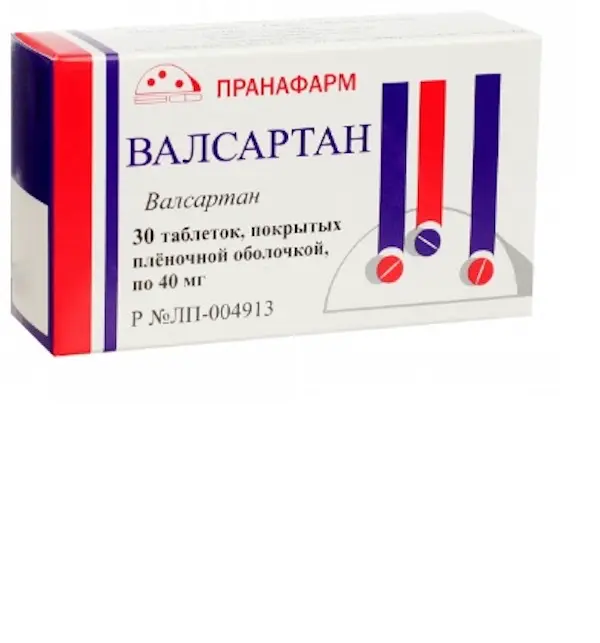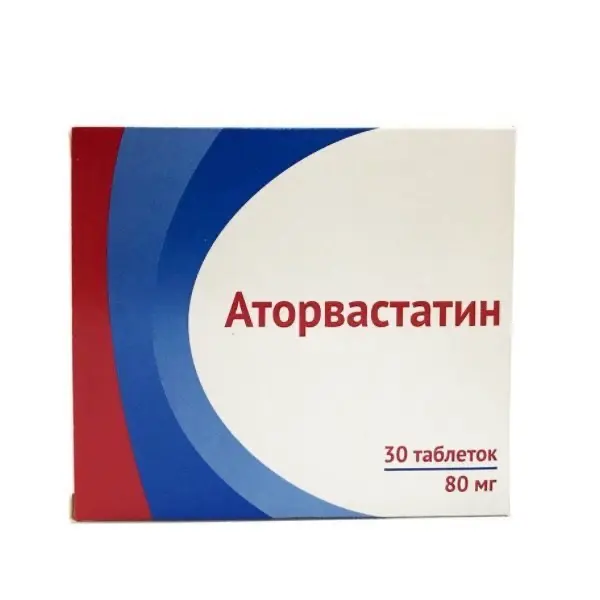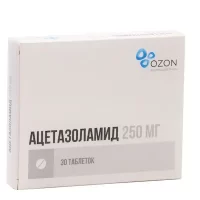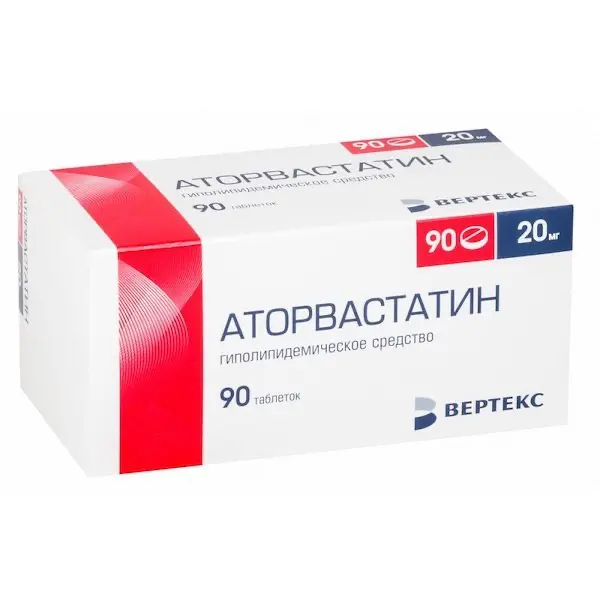Description
Valsartan Pharmacodynamics
Active specific angiotensin II receptor antagonist for oral administration. It selectively blocks receptors of subtype AT1, which are responsible for the effects of angiotensin II. The consequence of blocking AT1 receptors is an increase in the plasma concentration of angiotensin II, which can stimulate unblocked AT2 receptors. Valsartan has no significant antagonistic activity against AT1 receptors. The affinity of valsartan for AT1 receptors is approximately 20,000 times higher than for AT2 receptors.
Valsartan does not interact with or block other hormone receptors or ion channels that are important in regulating cardiovascular function.
The likelihood of coughing with valsartan is very low due to the lack of effect on angiotensin converting enzyme (ACE), which is responsible for bradykinin degradation.
A comparison of valsartan with an ACE inhibitor showed that the incidence of dry cough was significantly (p < 0.05) lower in patients receiving valsartan than in patients receiving an ACE inhibitor (2.6% versus 7.9%, respectively). In the group of patients who had previously developed dry cough when treated with an ACE inhibitor, this complication was noted in 19.5% of cases when treated with Valsartan and in 19% of cases when treated with a thiazide diuretic, while in the group of patients treated with an ACE inhibitor, cough was observed in 68.5% of cases (p < 0.05).
Indications
– Arterial hypertension.
– Chronic heart failure NYHA functional class II-IV in adult patients receiving standard therapy with one or more drugs from the following pharmacotherapeutic groups: diuretics, cardiac glycosides, ACE inhibitors or beta-adrenoblockers. The use of each of these drugs is not mandatory. Evaluation of patients with CHF should include assessment of renal function.
– To improve survival of patients after acute myocardial infarction complicated by left ventricular failure and/or LV systolic dysfunction, in the presence of stable hemodynamic parameters.
Children and adolescents
– Arterial hypertension in children and adolescents from 6 to 18 years of age.
Contraindications
– Hypersensitivity to valsartan or any of the components of the drug;
– Severe hepatic impairment (more than 9 points by Child-Pugh score), biliary cirrhosis and cholestasis;
– pregnancy;
– Breast-feeding period;
– under 6 years of age for arterial hypertension; under 18 years of age for other indications;
– concomitant use with aliskiren and drugs containing aliskiren in patients with diabetes mellitus and/or moderate or severe renal dysfunction (glomerular filtration rate (GFR) less than 60 ml/min/1.73 m2 body surface area);
– concomitant use with ACE inhibitors in patients with diabetic nephropathy.
Caution:
Impaired renal function with creatinine clearance (CK) less than 10 mL/min (no clinical data available); bilateral renal artery stenosis or artery stenosis of the single kidney; condition after renal transplantation; primary hyperaldosteronism; maintenance of diet with restriction of table salt intake; hyponatremia; conditions accompanied by decreased circulating blood volume (including diarrhea, vomiting, high-dose diuretic treatment); children and adolescents aged 6 to 18 with a CK of less than 30 ml/min, including those on hemodialysis; mild to moderate liver function impairment (? 9 points according to Child-Pugh scale) of non-biliary genesis without cholestasis phenomena; patients with CHF of II-IV functional class according to NYHA classification, whose renal function depends on the state of renin-angiotensin-aldosterone system (RAAS); aortic stenosis, mitral stenosis, hypertrophic obstructive cardiomyopathy; hereditary angioedema, or a history of angioedema during therapy with ARA II or ACE inhibitors (special care should be taken); concomitant use with other RAAS-inhibiting agents, such as ACE inhibitors or aliskiren.
Pregnancy and lactation:
Pregnancy .
As with any other drug that affects the RAAS, Valsartan should not be used in women planning to become pregnant. When prescribing any RAAS-acting drug, the physician should inform women of childbearing age about the potential dangers of these drugs during pregnancy.
As with any other drug that has a direct effect on the RAAS, Valsartan should not be used during pregnancy. Given the mechanism of action of ARA II, a risk to the fetus cannot be excluded. The effects of ACE inhibitors (drugs that also affect the RAAs) on the fetus, if used in the second and third trimesters of pregnancy, can lead to fetal damage and death. According to retrospective data, the use of ACE inhibitors in the first trimester of pregnancy increases the risk of birth defects. There have been reports of spontaneous abortions, oligohydramnios, and renal dysfunction in infants whose mothers inadvertently took Valsartan during pregnancy.
If pregnancy is diagnosed during treatment with Valsartan, treatment should be discontinued as soon as possible.
Breastfeeding period
It is not known whether valsartan is excreted with breast milk.
Use during breastfeeding is not recommended.
Fertility
There are no data on the effect of the drug on human fertility. No effects of valsartan on fertility have been observed in animal studies.
Dosage and administration
- Tablets should be taken orally without chewing, regardless of the meal, with water.
- Adults
- Arterial hypertension.
- The drug may be prescribed in doses of 40 mg, 80 mg, 160 mg, 320 mg.
- The recommended starting dose of Valsartan is 80 mg once daily, regardless of the race, age or sex of the patient.
- Antihypertensive effect is noted in the first 2 weeks of treatment; maximum effect develops after 4 weeks. In patients who do not achieve an adequate therapeutic response, the daily dose of Valsartan may be gradually increased to a maximum daily dose of 320 mg or additional diuretics should be used.
- Chronic heart failure II-IV functional class according to NYHA classification
- The recommended starting dose of Valsartan is 40 mg twice daily. The dose should be gradually increased over at least 2 weeks to 80 mg twice a day, and if tolerated well to 160 mg twice a day.
- The maximum daily dose is 320 mg in 2 doses. In this case, it may be necessary to reduce the dose of simultaneously taken diuretics.
- To improve survival of patients after acute myocardial infarction
- Treatment should be started within 12 hours after the myocardial infarction.
- The initial dose is 20 mg (1/2 tablet of 40 mg) 2 times a day.
- Other manufacturers’ valsartan preparations in the dosage form of “20 mg tablets” or in the form of 40 mg tablets with a slash should be administered to provide the indicated dosing regimen when 20 mg valsartan is required.
- Increase the dose by titration (40 mg, 80 mg, 160 mg twice daily) over the next few weeks, until the target dose of 160 mg twice daily is reached.
- The maximum daily dose is 320 mg in two doses. It is generally recommended that the dose be increased to 80 mg twice daily by the end of the second week of treatment. Reaching the maximum target dose of 160 mg twice daily is recommended by the end of the third month of therapy with Valsartan. Increasing the dose depends on the tolerability of Valsartan during the titration period.
- A dose reduction should be considered if arterial hypotension with clinical manifestations or renal dysfunction develops.
- Evaluation of patients after myocardial infarction should include evaluation of renal function.
- Use in special patient groups
- Patients with impaired renal function
- In patients with impaired renal function at a CKR of more than 10 ml/min, no dose adjustment is required. There are currently no data on the use of valsartan in patients with a GFR of less than 10 mL/min.
- Patients with liver dysfunction
- In patients with mild to moderate hepatic dysfunction of non-biliary origin without cholestasis, the daily dose should not exceed 80 mg.
- Patients aged over 65 years.
- No dose adjustment is required in elderly patients.
- Children and adolescents
- Arterial hypertension
- The recommended starting dose of Valsartan in children and adolescents aged 6 to 18 years is 40 mg if the body weight of the child is less than 35 kg and 80 mg if the body weight of the child is more than 35 kg. The dose is recommended to be adjusted to lower blood pressure.
- The maximum recommended daily doses are shown in the table below. Use of higher doses is not recommended.
- Body weight
- Maximum recommended daily dose
? 8 kg < 35 kg 80 mg
? 35 kg < 80 kg 160 mg
? 80 kg ? 160 mg 320 mg - Use in special groups of pediatric patients
- Administration in children and adolescents 6 to 18 years of age with renal dysfunction
- No study of Valsartan has been performed in patients 6 to 18 years of age with impaired renal function at a CKR of less than 30 mL/min or in pediatric patients on hemodialysis; therefore, it is not recommended for this group of patients.
- Valsartan dosage adjustment is not required in patients aged 6 to 18 years with a CKR greater than 30 mL/min. Renal function and plasma potassium should be carefully monitored while taking this drug.
- Administration in children and adolescents 6 to 18 years of age with hepatic impairment
- As in adult patients, valsartan is contraindicated in patients 6 to 18 years of age with severe hepatic impairment, biliary cirrhosis and cholestasis. There is limited experience with Valsartan in children and adolescents with mild to moderate hepatic impairment. The daily dose of valsartan 80 mg should not be exceeded in this group of patients.
- Chronic Heart Failure and Acute Myocardial Infarction
- Valsartan is not recommended for the treatment of chronic heart failure or for use after acute myocardial infarction in patients less than 18 years of age.





